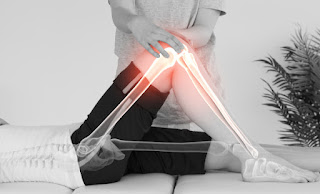Yoga for Knee or Hip Bursitis
Knee or Hip problems? Pain? Inflammation?*
* please read my medical disclaimer at the bottom of this blog post.
A common problem of the joints one that creates pain and inflammation is hip or knee bursitis.
What is busitis? The bursae are small sacs of fluid that cushions the different parts of a joint. They are situated between the bones and the tendons, muscles and skin near the joints to prevent friction and to cushion pressure points. Bursitis is an inflammation of one of these sacs. (Information adapted from Mayo Clinic Website www.mayoclinic.org ).
But let’s not get too caught up in the diagnosis or prognosis – we need to leave that to the medical professionals*.
What you want to know is how to soothe the joint pain for yourself. Most Drs. will recommend some form of very gentle movement therapy to keep the joint moving, but not anything intense that will create more inflammation.
What you want to know is how to soothe the joint pain for yourself. Most Drs. will recommend some form of very gentle movement therapy to keep the joint moving, but not anything intense that will create more inflammation.
This is why Kaiut Yoga is perfect. In Kaiut you are taught and encouraged to approach your body in a way that is strong and clear at the same time to keep your movements gentle, it can feel paradoxical to remove any aggression in your practice and yet still using sometimes a lot of pressure and gravity.
The whole practice challenges you to create presence and awareness in your body and mind, having a balance between intensity and relaxation, and to give you the ability to move into areas of restriction or pain without activating your fight or flight sympathetic nervous system.
So here are a simple set of 4 steps that can be useful in your yoga for knee or hip bursitis, knee or hip pain or inflammation.
So here are a simple set of 4 steps that can be useful in your yoga for knee or hip bursitis, knee or hip pain or inflammation.
Step One.
First thing is to lie on your back knees bent and feet flat on the floor.
Relax.
Keep your knees facing the ceiling and concentrate on relaxing. Every single tiny muscle in your body. The one stress that most people are unaware of but I can pretty much guarantee you are suffering from is the inability to relax.
But, I hear you say, of course you can't relax because you have joint pain and inflammation!
You probably feel that if in pain, your body will not settle until the pain is gone. Your whole nervous system is on alert and you are unable to rest. Let's introduce a new idea to the brain. This new idea is that wherever there is pain in your body, you can isolate it and you can tell the rest of your body to relax around it.
This is the first aspect of step one. RELAX through a body scan (many of my online classes end with a body scan meditation) to soften and relax all your body parts.
First thing is to lie on your back knees bent and feet flat on the floor.
Relax.
Keep your knees facing the ceiling and concentrate on relaxing. Every single tiny muscle in your body. The one stress that most people are unaware of but I can pretty much guarantee you are suffering from is the inability to relax.
But, I hear you say, of course you can't relax because you have joint pain and inflammation!
You probably feel that if in pain, your body will not settle until the pain is gone. Your whole nervous system is on alert and you are unable to rest. Let's introduce a new idea to the brain. This new idea is that wherever there is pain in your body, you can isolate it and you can tell the rest of your body to relax around it.
This is the first aspect of step one. RELAX through a body scan (many of my online classes end with a body scan meditation) to soften and relax all your body parts.
Step Two:
Explore the Pain.
SLOWLY explore the pain. Not doing anything to make it worse, but not avoiding it either. A soft approach, where you gently move it, is all the better. Move one leg at a time and see what movements of the knee or hip are possible without pain and then when you find a movement that triggers pain. Slow down. Go really slowly with tiny movements, we are talking movements of millimeters over minutes to discover more about the pain, where it occurs, what it feels like and how you trigger it and when it feels better or worse.
I usually recommend that students try not to resort to always using painkillers, they are excellent for short term relief, for offering a way to sleep or relax, but if you notice you are using them long term, and therefore needing to increase the doses to have effect, be aware they can create further complications.
Explore the Pain.
SLOWLY explore the pain. Not doing anything to make it worse, but not avoiding it either. A soft approach, where you gently move it, is all the better. Move one leg at a time and see what movements of the knee or hip are possible without pain and then when you find a movement that triggers pain. Slow down. Go really slowly with tiny movements, we are talking movements of millimeters over minutes to discover more about the pain, where it occurs, what it feels like and how you trigger it and when it feels better or worse.
I usually recommend that students try not to resort to always using painkillers, they are excellent for short term relief, for offering a way to sleep or relax, but if you notice you are using them long term, and therefore needing to increase the doses to have effect, be aware they can create further complications.
Step Three.
Scan The Body with the Brain
Differentiate and discover the map that your brain holds of the knee and the hip. As you place your awareness to think knee - what do you feel ? Most of you probably feel one fairly large area of the body. If you try and place your attention on your hip, can you feel all the different aspects of that hip joint?
Scan The Body with the Brain
Differentiate and discover the map that your brain holds of the knee and the hip. As you place your awareness to think knee - what do you feel ? Most of you probably feel one fairly large area of the body. If you try and place your attention on your hip, can you feel all the different aspects of that hip joint?
Mapping the body with the brain uses the power of differentiation. Whereby you feel the differences between the front, back, sides, top of your joints, once you have the feeling of them, then you will move them with more care and attention. Feel, and by making very slow and very tiny movements and keep feeling, you will make this differentiation of parts of a joint much clearer.
A Dr. works with images. A CAT scan or x-ray or MRI reveals a lot of extremely important information. However,you must remember your own ability to see and scan, determine and inquire into your own body. You can learn in great detail what is happening inside a joint if you are prepared to move it slowly, feel into it and if you are open to learn all about it.
When you add your own sensory perception and your own experience of the area of discomfort - and not just a "ouch, it hurts" you are in a much better position to find what exactly is the area of discomfort and therefore more able to move it in helpful ways, to keep the blood flowing around it and to gently strengthen and heal it.
So put yourself, through your awareness of your joints in the picture. You are the one who has to live with your knees, your hips and with the pain. It makes sense for you to you find out as much as you can, from the inside out, from your own perspective, on how do your joints function, not function, works or doesn’t work in your mind, and how your joints are mapped in your brain.
A healthier pain relief strategy is doing exercises that are good for the joints to create extra blood flow, and exercises that do not aggravate the inflammation or swelling.
Step Four.
Conscious Movement
Move the joints so that the blood flow can increase. This means applying pressure with a bend or a fold and holding for a period of time and then releasing.
Conscious Movement
Move the joints so that the blood flow can increase. This means applying pressure with a bend or a fold and holding for a period of time and then releasing.
This will help create new healing potential in that joint. Increasing blood flow can be hard because it can be painful. But moving very gently, very slowly, very deliberately, can mitigate any pain that might be there.
Then add some other yoga positions: Try leg lifts with knee extensions. As I said before, your explorations can and may involve discomfort, tightness, restriction or pain. Bend the knee and straighten the knee. From a lying down position. Watch how the hips can stay on the ground/ mat as you move. Try crossed legged - known as sukhasana - do it in the Kaiut method with legs away from the groin. This is designed specifically to highlight the restriction in the hips - when the legs are moved away from the groin a good distance it can be more painful (see step two and explore the pain!).
You can have access to 3 free videos where I show these postures in more detail if you are by signing up to my newsletter. Sign up to Kathy White Yoga here
So there you have it. Four simple steps to explore and discover about keeping your joints moving even if you have bursitis.
* Medical Disclaimer: This blog post is in no way a substitute for any medial advice. When approaching any joint pain in your yoga practice, you need to be aware of any diagnosis you have. Please make sure your Dr. consents for you to do yoga and to make sure there are no other complications that may be counter-indicative. Please consult your Dr. physiotherapist or other medical professional to get help for healthy joint functioning.
For Free Videos and more visit www.kathywhiteyoga.com or on @kathywhiteyoga on Facebook







Comments
Post a Comment